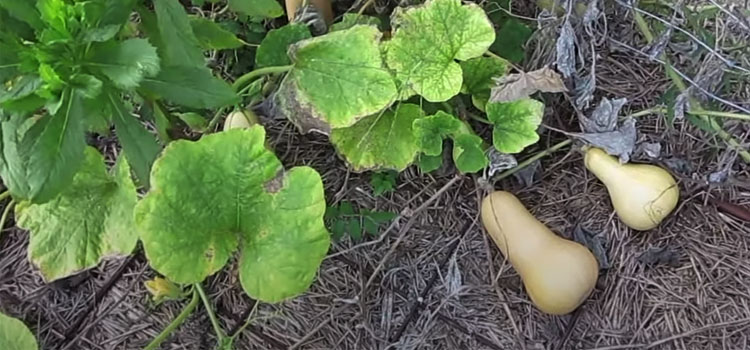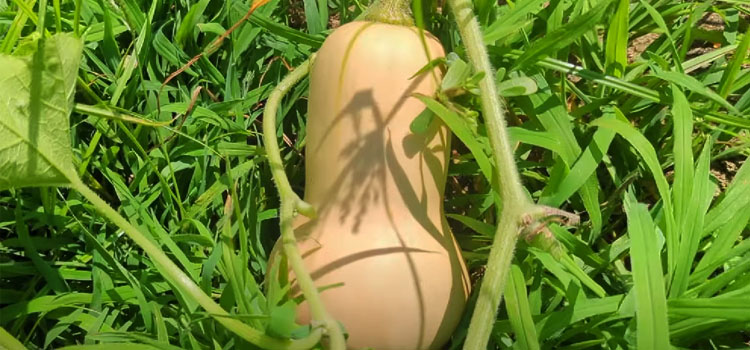Last Updated on September 16, 2024 by Shari Mason
Farmers sometimes pick butternut squash before it’s fully grown—kind of like snapping a picture of a sunny day to enjoy later.
I wondered if these picked squash can become tasty on their own.
The question is, can they get yummier even after leaving the vine? Will butternut squash ripen off the vine?
Let’s find out in a simple way, just like when my grandma explained things to me.
Is Butternut Squash Typically Harvested Ripe?


Butternut squash [1] is typically harvested when mature but not fully ripe. This means it has developed its characteristic shape, color, and hard skin but may have yet to reach its peak sweetness and flavor.
Harvesting it at this stage ensures that it can be stored for an extended period without spoiling.
However, butternut squash does have the potential to continue ripening after being picked under the right conditions.
“I make a really delicious eggplant and squash curry that’s inspired by Vij of Vij’s Restaurant, a great chef and restaurateur in Vancouver. I like to cook that dish because it’s really simple, but the flavor is so pungent and intense that I feel like I’m a real chef whenever I create it.”
– Carmen Ejogo, British Actress
Understanding when it’s mature enough to be harvested and how to encourage further ripening can help you enjoy the best flavors from this versatile winter squash.
Related Articles:
- What To Serve With Butternut Squash Soup?
- How To Roast A Whole Butternut Squash?
- Is Butternut Squash The Same As Spaghetti Squash?
- How To Tell If Butternut Squash Is Bad?
What Does A Ripe Butternut Squash Look Like?
A ripe butternut squash exhibits several visual cues indicating its consumption readiness. Firstly, its skin should have transformed into a rich, creamy beige or tan color, free from any greenish tinge.
The skin should also feel hard and pressure-resistant, ensuring its protective shell is intact.
When you gently tap it, a ripe butternut squash will produce a deep, hollow sound, indicating that the flesh inside is firm and well-developed.
Lastly, the stem of the squash should appear dry and corky, a sign that it has reached maturity. These visual and tactile indicators collectively signify that the butternut squash is at its sweetest and most flavorful state, making it ideal for various culinary applications.
How Can I Ripen Butternut Squash After Harvest?
- Warm and Dry Environment: Find a warm, dry, and well-ventilated area in your home. Avoid places with excessive humidity, as this can lead to mold growth.
- Arrange in a Single Layer: Place the harvested butternut squash in a single layer, ensuring they don’t touch each other. This allows for even air circulation around each squash.
- Monitor Regularly: Check on the squash regularly to assess their progress. They should gradually develop a sweeter aroma and may begin to turn a deeper color.
- Optimal Temperature: The ideal temperature for ripening butternut squash is between 50°F and 55°F (10°C to 13°C). Maintaining this temperature range can aid the ripening process.
- Patience is Key: Ripening can take anywhere from a few weeks to several months, depending on various factors such as the initial maturity of the squash and the storage conditions.
Are There Varieties That Ripen Better Off The Vine?


Yes, some butternut squash varieties tend to ripen better off the vine than others. While most butternut squash varieties can continue to ripen after being harvested, some may exhibit more robust post-harvest ripening characteristics.
Varieties known for their post-harvest ripening include the Waltham Butternut and the Hunter Butternut [2].
These varieties often sweeten and develop their flavors more readily once they are off the vine and stored correctly.
“Like a fine wine, butternut squash too can improve with time. Understanding the journey from vine to plate reveals the sweet secret – that the magic of ripening doesn’t stop once it’s picked.”
– Eat Pallet Restaurant & Food Advice
However, it’s essential to note that proper storage and environmental conditions significantly encourage post-harvest ripening for any butternut squash variety.
What’s The Best Way To Store Butternut Squash For Ripening?
- Please keep it in a dry, well-ventilated area with temperatures around 50°F to 55°F (10°C to 13°C).
- Ensure the squash is not touching each other to allow proper air circulation.
- Regularly check for ripening cues such as color change and aroma development.
FAQs
u003cstrongu003eWhat can you do with unripe butternut squash?u003c/strongu003e
Unripe butternut squash can still be put to good use. While it may lack the sweetness of fully ripened squash, you can use it in savory dishes like soups stews or even as a substitute for pumpkin in recipes. u003cbru003eu003cbru003eCooking unripe butternut squash with flavorful ingredients can help balance its less sweet taste, making it a versatile addition to your culinary creations.
u003cstrongu003eHow long does it take for butternut squash to ripen on the vine?u003c/strongu003e
The time it takes for butternut squash to ripen on the vine typically ranges from 80 to 100 days after planting the seeds. u003cbru003eu003cbru003eFactors like temperature, sunlight, and the squash variety can influence the ripening duration.
Key Takeaways
Butternut squash does have the potential to ripen off the vine, provided you follow the proper storage conditions and practices.
While it is commonly harvested when mature but not fully ripe, the squash can continue to sweeten and develop its flavors post-harvest.
Key factors include selecting a warm, dry, well-ventilated storage area, monitoring for ripening cues like color change and aroma development, and maintaining optimal temperatures.
Different squash varieties may exhibit varying post-harvest ripening characteristics, with some varieties known for ripening more readily.
By understanding and implementing these practices, you can maximize your butternut squash harvest, ensuring it reaches its peak flavor and sweetness.
References:
- https://www.goodhousekeeping.com/food-recipes/g767/butternut-squash-recipes/
- https://www.thespruceeats.com/top-butternut-squash-recipes-4063130
- Can You Put an AC Unit in the Kitchen? - September 27, 2024
- What Cheese Does Olive Garden Use? Discover Their Signature - September 27, 2024
- How to Cancel a Pizza Hut Order? Quick & Easy Guide - September 24, 2024


